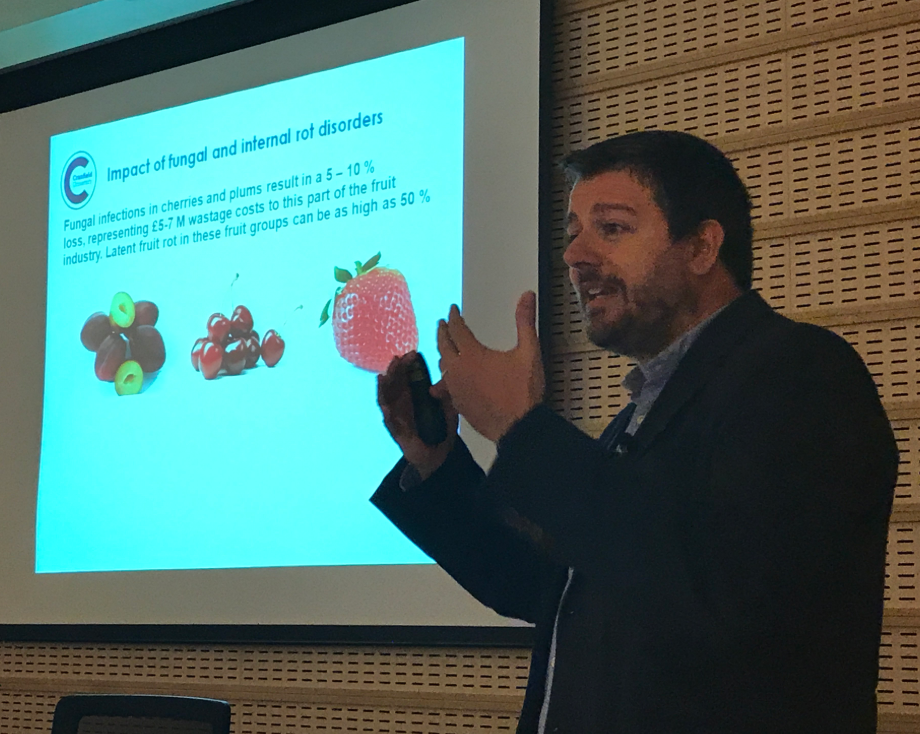Early detection of fungal pathogens in fruits
23/09/2019

Recently Dr Angel Medina presented at the Postharvest workshop organised by (IRTA). He shared his research on early detection of fungal pathogens in fruits and vegetables using volatile organic compound (VOC) biomarkers.
Volatile organic compounds are compounds that easily become vapours or gases and can be sampled through breath or diet and are used to detect fungal pathogens. VOC biomarkers provide a non-invasive and quick approach to detect fungal pathogens.
Examples of where VOCs have been used for early identification of fungal and bacterial rots is in the spoilage of fruits and vegetables. Fungal infections in cherries and plums result in a 5-10% loss representing a cost of £5-7 million in wastage in this section of the fruit industry. Detection of disorders post storage and prior to market would enable infected fruit to be safely marketed early to reduce loss. There are many advantages to identifying biomarkers such as the detection of disorders post-harvest which would enable infected produce to be isolated resulting in a reduction in the spread of infection and thusly enabling better crop management.
The results indicate that the prototype validation for strawberries show the amount of biomarkers detected or emitted depend on a number of parameters such as the fruit origin, variety, size as well as punnet size and temperature. The data analysis of this is very challenging due to the number of parameters that affect the result.
The current progress in the research project is that there is a detection system which has been built to monitor latent fungal infection emitted by strawberries. The system built is fit for purpose in terms of sensitivity, speed and ease of use. It is to be further investigated as to whether other fruits and vegetables may be able to give more reliable information as analysing the data from strawberries has been challenging.
Categories & Tags:
Leave a comment on this post:
You might also like…
Come to a virtual study session in May
What are virtual study sessions? These are online study sessions facilitated by Library staff, where you can study independently alongside other students via Teams. They are a great way for you to dedicate specific time ...
Getting started on your School of Management thesis
Writing a thesis, business plan, internship project or company project can be a daunting task, and you might have some uncertainty or questions around how to get started. This post will share some ideas and ...
Sustainability by royal request: Managing an event fit for a King
The Coronation of King Charles III on May 6th 2023, was watched by millions of people around the world with tens of thousands of people travelling to Central London to witness the pageantry firsthand. ...
Getting started on your Master’s thesis
Please note: This post is intended to provide advice to all students undertaking a thesis in the Schools of Aerospace, Transport and Manufacturing; Water, Energy and Environment, and Defence and Security. There is separate advice ...
Finding your tribe: “Joining the sustainability community was the best decision”
For students on Cranfield’s Sustainability Business Specialist Apprenticeship, community and camaraderie is a vital component for success. Designed in consultation with industry, the part-time Level 7 apprenticeship aims to deepen participants’ knowledge of the ...
“My sustainability studies gave me the confidence to take on Amazon”
Not everyone would have the confidence to challenge a big global power like Amazon but, for Colin Featherstone, Senior Technology Manager and Tech Sustainability Lead at Morrisons, his Cranfield studies equipped him with the ...






